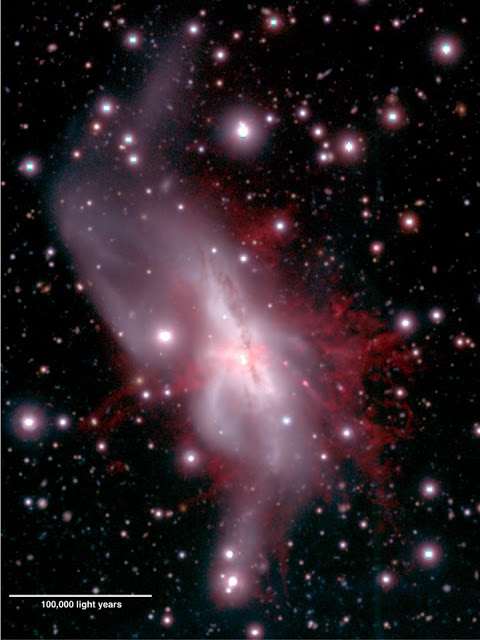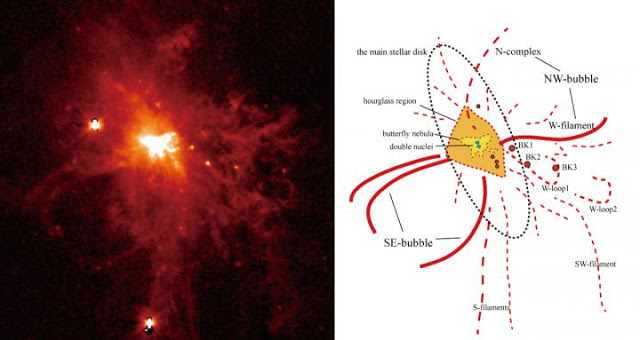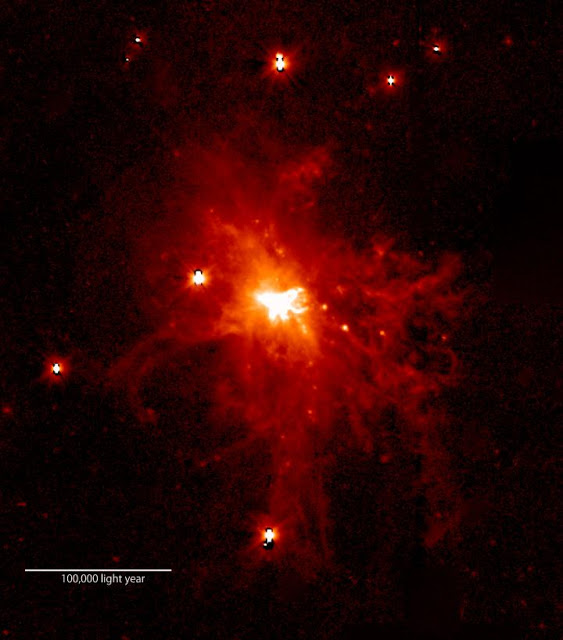

| Online: | |
| Visits: | |
| Stories: |

| Story Views | |
| Now: | |
| Last Hour: | |
| Last 24 Hours: | |
| Total: | |
Superwinds Driven by Star Births and Star Deaths
The ionized gas the astronomers observed extends across 300,000 light-years and is carried out of the galaxy by a powerful superwind. That wind is driven by intense star-forming activity at the galactic center. The light-collecting power and high spatial resolution of Subaru Telescope made it possible to study, for the first time, the complex structure of one of the largest known superwinds being driven by star birth – and star death.
Blue, green, and red colors are attributed to the B-band, R-band, and H-alpha (emission line from ionized hydrogen gas) images, respectively. The giant ionized gas blown out from the galaxy is seen in red.

Credit: Hiroshima University / NAOJ
Starburst activity is a very important part of galaxy evolution. When a starburst occurs, the intense episode star formation rapidly consumes the galaxy’s interstellar gas. In addition, ultraviolet light from newborn massive stars as well as gas heating and ram pressure from supernova explosions blows much of a galaxy’s gas away into intergalactic space. This galactic-scale energetic wind is called a “galactic wind” or “superwind”. Its action forces interstellar gas out of the galaxy very efficiently, which accelerates the galaxy’s gas-loss rate. It also chokes off star formation.
The metal-rich gas expelled from the galaxy’s disk pollutes its halo as well as intergalactic space. Consequently, starburst and starburst-driven superwind significantly affect the evolution of the galaxy and the gas outside of that galaxy.
This image was produced by subtracting the stellar continuum light from the H-alpha image and extracting the pure (net) H-alpha emission. The complicated filamentary structure extends over hundreds of thousands light years.
NGC 6240 is a starburst galaxy fairly close to the Milky Way, at a distance of about 350 million light-years. Its SFR is estimated to be 25-80 times that of our galaxy. It has a peculiar, disturbed morphology which indicates that two spiral galaxies are merging. Due to the giant starburst at its heart as a result of the merger, NGC 6240 is very bright in infrared light being emitted from heated dust. The total infrared luminosity reaches almost a trillion times of that the Sun’s.
NGC 6240 is an important object to investigate in order to understand the physical and evolutional relationship among the processes of galaxy merger, the action of a starburst, and the phenomenon of an active galactic nucleus. Hence, it is one of the most-studied starburst galaxies in the nearby universe within 500 million light-years of the Sun.
The research team wanted a wide-field of NGC 6240. The Suprime-Cam optical camera was used on Subaru Telescope to zero in on the detailed structure of the starburst-driven superwind. In addition, the team searched for important clues to understanding the starburst history of NGC 6240. They observed the galaxy using a special band-pass filter that selectively transmits the light around an emission line produced by ionized hydrogen (called the H-alpha emission line). It allowed them to study the structure of the ionized gas associated with the superwind.
Their unprecedented deep observation (long-exposure images) revealed a complex giant ionized gas nebula (called an “H-alpha nebula”) surrounding NGC 6240. This nebula extends out about 300,000 light-years and contains complicated structures of filaments, loops, and blobs.
a) Right panel: Same as Figure 2. The giant ionized gas nebula (H-alpha nebula) of NGC 6240. This image was produced by subtracting the stellar continuum light from the H-alpha image and extracting the pure (net) H-alpha emission. The complicated filamentary structure extends over hundreds of thousands light years. b) Left panel: A sketch of the H-alpha nebula of NGC 6240.

Credit: Hiroshima University / NAOJ
The research team performed detailed data analysis and found that NGC 6240 has experienced violent starbursts at least three times in the past and each starburst drove an energetic superwind. Those superwinds form complex structure in the H-alpha nebula. The oldest starburst started about 80 million years ago.
Source:



